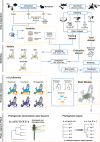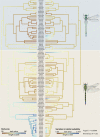Climate change will redefine taxonomic, functional, and phylogenetic diversity of Odonata in space and time
- PMID: 39242770
- PMCID: PMC11290607
- DOI: 10.1038/s44185-022-00001-3
Climate change will redefine taxonomic, functional, and phylogenetic diversity of Odonata in space and time
Abstract
Climate change is rearranging the mosaic of biodiversity worldwide. These broad-scale species re-distributions affect the structure and composition of communities with a ripple effect on multiple biodiversity facets. Using European Odonata, we asked: i) how climate change will redefine taxonomic, phylogenetic, and functional diversity at European scales; ii) which traits will mediate species' response to global change; iii) whether this response will be phylogenetically conserved. Using stacked species distribution models, we forecast widespread latitudinal and altitudinal rearrangements in Odonata community composition determining broad turnovers in traits and evolutionary lineages. According to our phylogenetic regression models, only body size and flight period can be partly correlated with observed range shifts. In considering all primary facets of biodiversity, our results support the design of inclusive conservation strategies able to account for the diversity of species, the ecosystem services they provide, and the phylogenetic heritage they carry in a target ecosystem.
© 2022. The Author(s).
Conflict of interest statement
The authors declare no competing interests.
Figures





References
-
- Diamond, S. E. Contemporary climate‐driven range shifts: putting evolution back on the table. Functional Ecol.32, 1652–1665 (2018). 10.1111/1365-2435.13095 - DOI
LinkOut - more resources
Full Text Sources

